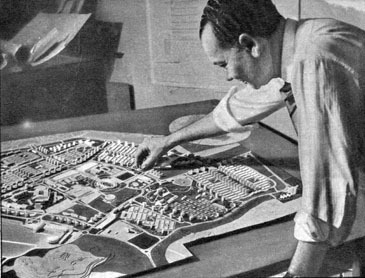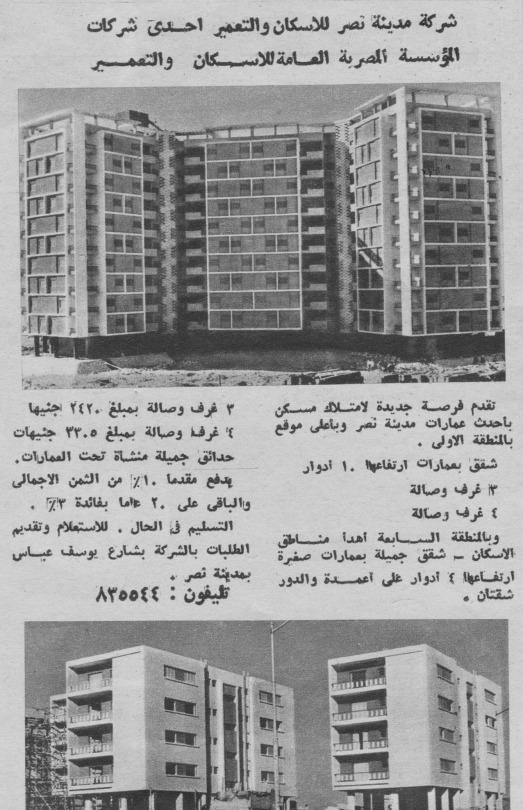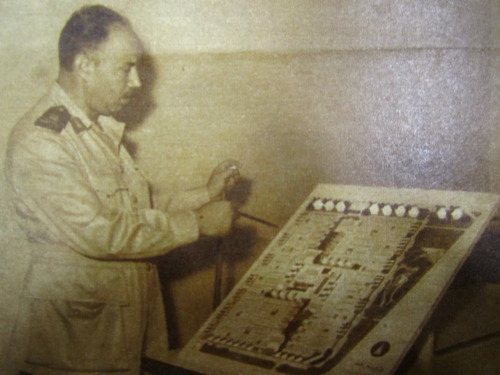Nasr City was once Egypt’s new capital, but things went wrong.

[Architect Sayed Karim pictured with his maquette of Madinet Nasr]
Mohamed Elshahed
One of Cairo’s least liked planned districts today, Madinet Nasr (Nasr City), was once intended to be Egypt’s new capital city. In fact it was billed in 1958 as “City of the Revolution” by the military regime that took power in 1952 and sought to establish its legitimacy through building and development projects across the country. In light of the Egyptian government’s recent announcement of its intentions to build a
new capital city, many of the statements used to promote the project
recall how in the late 1950s Madinet Nasr was presented to the public.
The
initial urban plan and architectural designs, mostly by architect and
planner Sayed Karim, were in tune with the times. The project’s brochure
contained English rather than Arabic text and was designed to attract
educated upper and middle class potential residents whom it assured that the new
city would be “planned according to the latest theories of city
planning.” An orthogonal plan composed of “super blocks” each containing apartments too expensive for the poor and largely catering to the
new middle class. The originally planned apartments ranged from
two-bedroom to four-bedroom duplexes. Each “super block” was to include
services and green spaces. A series of new administrative buildings were
planned (and some built) to house new ministries and to relocate others
from the downtown area. This was meant to be a modern city that reflects
the progress of the new regime.

[Advert
for the new apartments in Madinet Nasr, 3 bedrooms+living room priced
2320 LE, 4 bedrooms+living room priced 3305 LE, to be paid %10
immediately and the rest over 20 years at a rate of %3 interest. An
average monthly salary at the time was around 17-20 LE]
But what went wrong? Today Madinet Nasr is chaotic, mismanaged (like the rest of Cairo and all of Egypt’s cities), congested with vehicular traffic in the absence of an effective public transport network, and the district’s density continues to escalate as low-rise residential buildings have long disappeared to give way to speculative apartment towers by developers. Furthermore, no one thinks of Madinet Nasr today as an independent city, its name has long become an anachronism referring to a brief moment in which the new city in the desert was meant to be that, a city. But its proximity to Cairo has made it today nothing more than an extension of the existing capital. So what is the story behind this former city of the future?
After 1953, the new
regime was struggling to tackle urban demands for better services and
more affordable housing. While popular (low-income) housing projects struggled to
meet demand and to be economically feasible, the state took on Madinet
Nasr, a large-scale urban development plan. In a company publication from the 1970s, the head of the
Nasr City Company Gamal Eddin Fahim stated that “our heroic
brethren, who struggled against occupation until our country was
cleansed from
it in 1956, have since then studied and planned for ways to raise our
people’s
standards of living and to fulfill the wishes of president Nasser and
Sadat
after him.” Nationalist politics were deployed to silence all voices in
favor of the visions of presidents, Nasser and Sadat after him, and the
city became a terrain for that singular voice of a president to showcase
his vision (or delusion).
According to Sayed Karim’s handwritten account of the founding of Madinet Nasr, in the early 1950s when he proposed his project to the municipality and various ministries, they refused to consider it because they saw his proposed expansion of Cairo as conflicting with the ideals of socialism. However, after a chance meeting with then officer Anwar Sadat, who was impressed by the architectural model of the city, Gamal Abdel Nasser gave a presidential order for its construction. Sayed Karim achieved his grandest commission by appealing directly to the highest echelons of political power. By the late 1950s Karim presented the plan not as a residential expansion of Cairo, as he originally envisioned it, but as a new capital with government offices, a stadium, and a convention center.

[A military parade with the first phase of Madinet Nasr 10-story apartment buildings seen in the background]
The design, implementation
and management of the new “city of the revolution” in 1950s Egypt was void of any
form of participation by the public or the future residents. It was a typical
high modernist development project that was built in the name of “the people”
as mere recipients of state-sanctioned modernity. The objectives of the newly
established Madinet Nasr Foundation (that later became the Nasr City Company) were as follows: to provide a new urban
model for desert expansion; to alleviate the housing crisis and population
density in central Cairo; to provide new governmental headquarters; to provide
housing for government workers; to provide serviced residential areas for
rental and ownership; to expand infrastructure into desert lands in order to be
sold “at a fair price” for private development; to connect the suburban
district of Heliopolis to the center of Cairo via new roads and public
transport options (at the time, only a single road linked Heliopolis to the
rest of Cairo).
The new city was positioned
east of the Abbasiya district, where military barracks were located, and
south
of the suburban enclave of Heliopolis. The total area of the project was
1200
square kilometers with the planned area as only phase one of a much
larger vision for expansion. Much of this was military-owned land.
Madinet Nasr was
ultimately a new district, rather than a new capital city in the fullest
sense but this status was ambiguous during the first decade and a half
after its announcement in 1958.
The development still relied on its connection to the existing historic
capital.
Although some governmental offices moved to Madinet Nasr, the major
symbols of
state power such as the parliament remained in the downtown area.

[Military officer giving a presentation about housing in the city of the future, Madinet Nasr]
Construction of the new district/city
was slow. In 1966, seven years after the presidential decree for the
establishment of Madinet Nasr, it was still discussed in the press as a plan
rather than as a reality. In addition to its slow
construction, families and workers were reluctant to move because of its
distance from the center of the city and the lack of effective transport
networks. Furthermore, the development’s lack of low-income housing forbid the majority
of those in need of housing from moving there.
By the mid-1970s, Madinet Nasr was still a work in progress in a perpetual state of construction and low
occupancy rates. It had failed to create the revolutionary urban setting it
promised, thus making visible the state’s inability to organize space as an
expression of its power. It also failed to respond to the pressing housing
crisis that had plagued Egyptian society for two decades.
With infitah
policies the state retreated from its position as the sole developer of
large-scale projects and opened the door for speculative developers to
enter the scene and build residential buildings that did not comply with
the original plan in hopes of maximizing profit. In the meantime the
state also retreated from its role as a manager of cities through its
institutions that could have allowed citizens to participate in their
everyday urban affairs. Governors continued to be appointed and
municipalities failed to carryout the most basic services from trash
collection to maintaining parks and trees.
Announcements and images of buildings and urban projects such as Madinet Nasr (or the new capital proposal now) aim to serve a legitimating function and to provide visible evidence of a developmental state responding to popular demands for change. However, without effective public institutions that value the well-being of all residents of the city such developments are doomed to failure as they already have in Egypt. I would argue that the failure of Madinet Nasr isn’t to be blamed only on the designs provided by architects and planners of the original vision. In my view, the failure of this past attempt at building a future city (and at managing the current one) is due to the reluctance of Egypt’s political power to allow for society any capacity to participate in controlling its urban present and envisioning and realizing its urban future.
*Much of this post is extracted from an upcoming chapter titled “Cities of Revolution: on the politics of participation and municipal management in Cairo“ appearing in Participation in Art and Architecture: Spaces of Participation and Occupation (2015), edited by Martino Stierli and Mechtild Widrich.
**A lengthier and more detailed discussion of Madinet Nasr appears in my dissertation “Revolutionary Modernism? Architecture and the Politics of Transition in Egypt, 1936-1967.”
169 notes
 ayman-109 liked this
ayman-109 liked this alshareefsam liked this
 fox911 liked this
fox911 liked this confahmal liked this
 remusluqins liked this
remusluqins liked this  epharao reblogged this from cairobserver
epharao reblogged this from cairobserver  epharao liked this
epharao liked this kholodelkinanii-blog liked this
 arquigraph liked this
arquigraph liked this  wizzatron reblogged this from cairobserver
wizzatron reblogged this from cairobserver boudicathebrave reblogged this from bloglikeanegyptian
territorealities reblogged this from cairobserver
 sexybanano reblogged this from bloglikeanegyptian
sexybanano reblogged this from bloglikeanegyptian  ayarambles liked this
ayarambles liked this mybrainproblems reblogged this from abaegel
abaegel reblogged this from soso-surprise
soso-surprise reblogged this from bloglikeanegyptian
soso-surprise liked this
visirion reblogged this from bloglikeanegyptian
kshshu liked this
alexsankara liked this
tradramblings reblogged this from bloglikeanegyptian
countessdemontecristo liked this
visirion liked this
sokarplum reblogged this from bloglikeanegyptian
willempiresevercollapse liked this
 nour-ishment liked this
nour-ishment liked this handaza reblogged this from cairobserver
handaza liked this
x-infatuation liked this
luscious-coptic-curls liked this
tomarza-blog liked this
zoghbyzovic liked this
zoghbyzovic reblogged this from cairobserver
eclipsedbythe-moon liked this
 estimada-clienta-de-telmex liked this
estimada-clienta-de-telmex liked this mountpyre reblogged this from bloglikeanegyptian
infinite-scrolling reblogged this from cairobserver
bebowonder reblogged this from cairobserver
cairobserver posted this
- Show more notes

